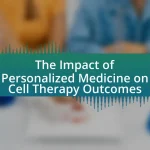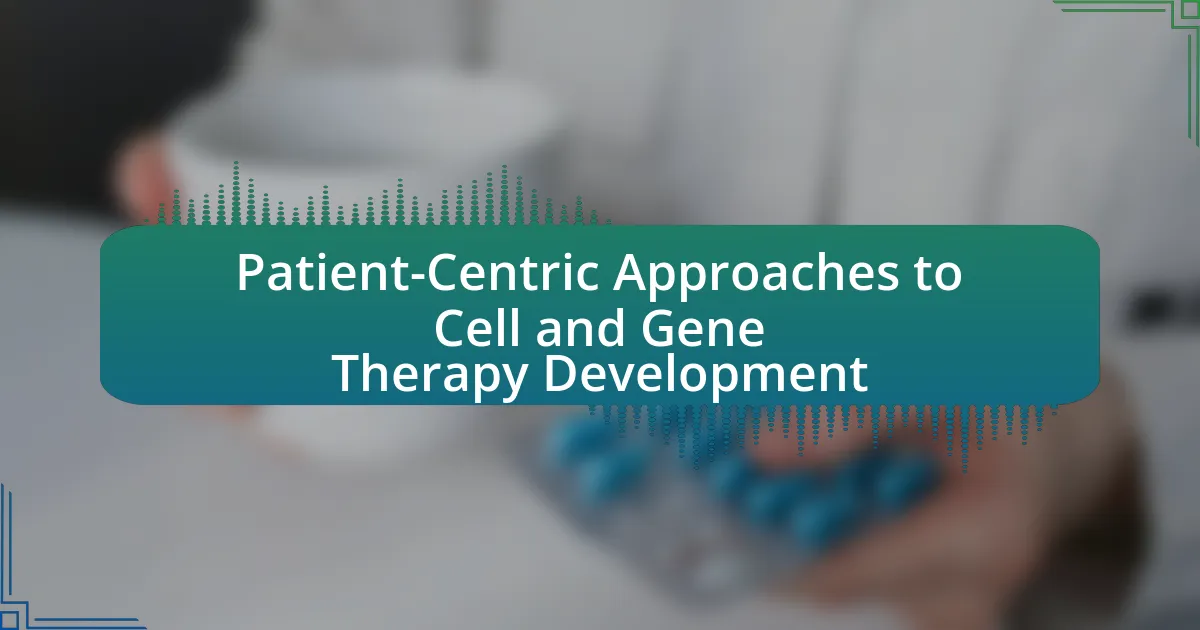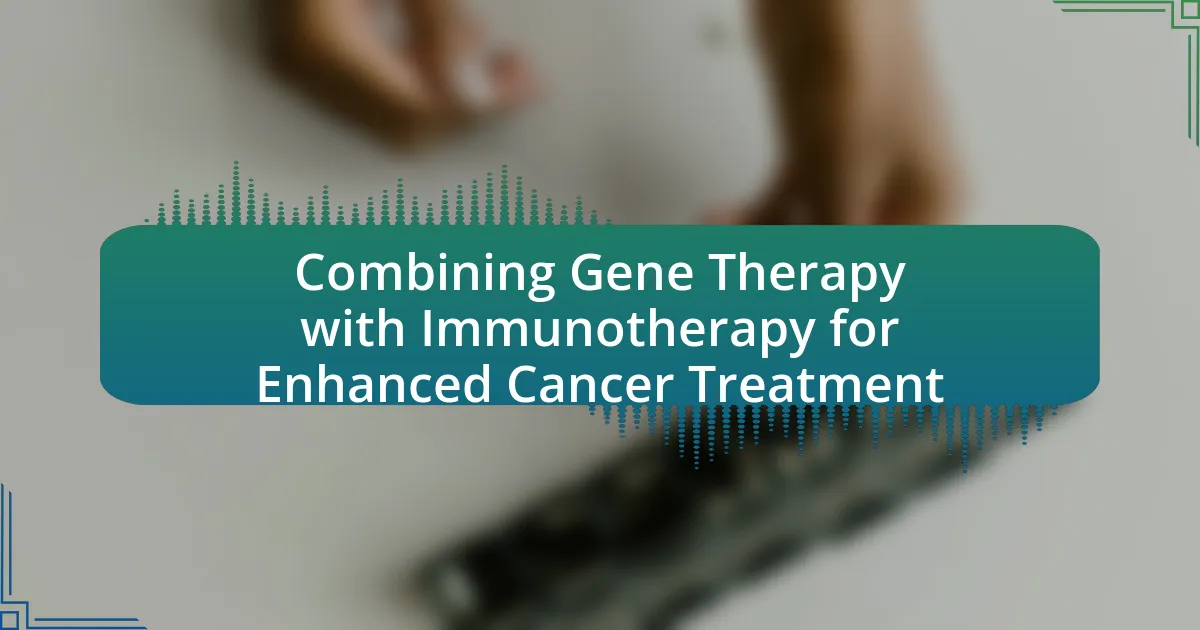Innovative approaches to treating rare genetic disorders with cell therapy focus on advanced techniques such as gene editing and stem cell therapy. Key methods include CRISPR-Cas9 for precise genetic modifications and the use of induced pluripotent stem cells (iPSCs) for personalized treatments. These therapies aim to correct underlying genetic defects rather than merely managing symptoms, offering potential long-term benefits and improved patient outcomes. The article also addresses the challenges of treating rare genetic disorders, including regulatory hurdles, high costs, and the need for ongoing research and funding to enhance access to these innovative therapies.
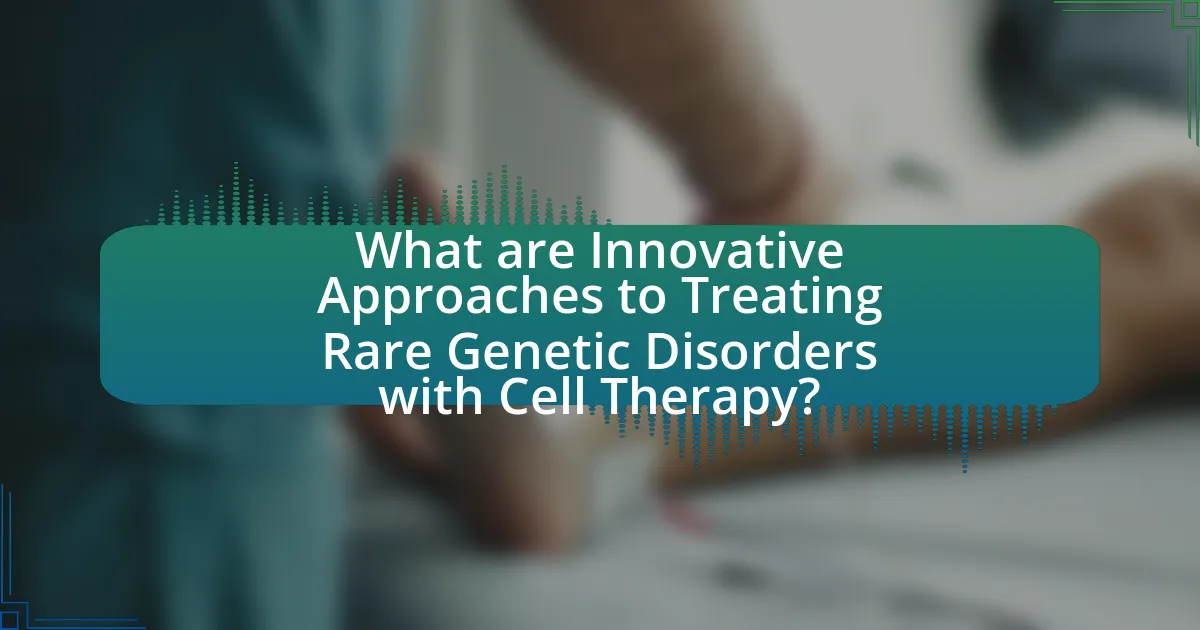
What are Innovative Approaches to Treating Rare Genetic Disorders with Cell Therapy?
Innovative approaches to treating rare genetic disorders with cell therapy include gene editing techniques such as CRISPR-Cas9, which allows for precise modifications of genetic material to correct mutations. These techniques have shown promise in clinical trials, demonstrating the ability to effectively target and repair genetic defects associated with disorders like sickle cell disease and beta-thalassemia. Additionally, the use of induced pluripotent stem cells (iPSCs) enables the generation of patient-specific cells that can be used for personalized therapies, reducing the risk of immune rejection. Research published in “Nature” by Liu et al. (2020) highlights the successful application of these methods in restoring normal function in affected tissues, providing a strong foundation for future treatments.
How do these innovative approaches differ from traditional treatments?
Innovative approaches to treating rare genetic disorders with cell therapy differ from traditional treatments primarily in their mechanism of action and specificity. Traditional treatments often focus on managing symptoms or replacing missing substances, whereas innovative cell therapies aim to correct the underlying genetic defects by utilizing modified cells to restore normal function. For instance, gene editing techniques like CRISPR can directly alter the DNA in patient cells, offering a potential cure rather than just symptomatic relief. This shift towards targeting the root cause of genetic disorders represents a significant advancement in treatment efficacy and patient outcomes.
What are the key characteristics of cell therapy in this context?
Cell therapy in the context of treating rare genetic disorders is characterized by its ability to modify or replace defective genes and restore normal function. This approach often involves the use of stem cells or genetically engineered cells to target specific genetic mutations. For instance, therapies like CAR-T cell therapy have demonstrated efficacy in treating certain blood disorders by reprogramming a patient’s immune cells to attack diseased cells. Additionally, the precision of cell therapy allows for personalized treatment plans tailored to individual genetic profiles, enhancing therapeutic outcomes. The success of these therapies is supported by clinical trials, such as those published in the New England Journal of Medicine, which highlight significant improvements in patient conditions following cell-based interventions.
Why are rare genetic disorders particularly challenging to treat?
Rare genetic disorders are particularly challenging to treat due to their low prevalence, which limits research funding and the development of targeted therapies. The rarity of these conditions often results in a lack of understanding of their underlying mechanisms, making it difficult to create effective treatments. For instance, according to the National Institutes of Health, there are over 7,000 known rare diseases, affecting approximately 30 million people in the United States alone, yet only a small fraction have approved therapies. This disparity highlights the significant barriers in clinical trials, regulatory approval, and the need for specialized expertise, all of which complicate the treatment landscape for rare genetic disorders.
What types of cell therapies are being explored for rare genetic disorders?
Gene therapy and stem cell therapy are the primary types of cell therapies being explored for rare genetic disorders. Gene therapy aims to correct or replace defective genes responsible for disease development, while stem cell therapy focuses on using stem cells to regenerate damaged tissues or produce healthy cells. For instance, in conditions like spinal muscular atrophy, gene therapy has shown significant promise by delivering a functional copy of the SMN1 gene, which is crucial for motor neuron health. Additionally, clinical trials are investigating the use of hematopoietic stem cell transplantation for disorders such as sickle cell disease, where the goal is to replace defective blood cells with healthy ones. These approaches are supported by ongoing research demonstrating their potential to provide long-term benefits for patients with rare genetic disorders.
How do stem cell therapies contribute to treatment options?
Stem cell therapies significantly enhance treatment options by providing regenerative capabilities that can repair or replace damaged tissues and organs. These therapies utilize the unique properties of stem cells, which can differentiate into various cell types, to target specific genetic disorders. For instance, in conditions like spinal muscular atrophy, stem cell therapy has shown potential in restoring motor function by replacing defective motor neurons. Clinical trials have demonstrated that patients receiving stem cell treatments often experience improved outcomes, highlighting the effectiveness of this approach in managing rare genetic disorders.
What role do gene-edited cells play in these therapies?
Gene-edited cells are crucial in therapies for rare genetic disorders as they enable the correction of genetic mutations at the cellular level. These cells are modified using techniques like CRISPR-Cas9 to precisely alter DNA sequences, thereby restoring normal function or eliminating disease-causing genes. For instance, in conditions such as sickle cell disease, gene-edited hematopoietic stem cells can produce healthy red blood cells, significantly improving patient outcomes. This approach has been validated in clinical trials, demonstrating the potential of gene editing to provide long-lasting therapeutic effects by addressing the root cause of genetic disorders.
What are the potential benefits of using cell therapy for rare genetic disorders?
Cell therapy offers significant potential benefits for treating rare genetic disorders by addressing the underlying genetic defects at the cellular level. This approach can restore normal function by replacing or repairing damaged cells, which is particularly crucial for disorders caused by single-gene mutations. For instance, gene editing techniques like CRISPR-Cas9 have shown promise in correcting mutations in diseases such as sickle cell anemia and beta-thalassemia, leading to improved patient outcomes. Additionally, cell therapy can enhance the body’s immune response against diseases, as seen in the use of CAR T-cell therapy for certain genetic conditions. These advancements indicate that cell therapy not only targets symptoms but also aims to provide long-term solutions by modifying the genetic basis of rare disorders.
How can cell therapy improve patient outcomes?
Cell therapy can improve patient outcomes by enabling the repair or replacement of damaged cells and tissues, thereby addressing the underlying causes of diseases. For instance, in the treatment of rare genetic disorders, cell therapy can provide functional copies of defective genes through techniques such as gene editing or the introduction of healthy stem cells. Research has shown that therapies like CAR-T cell therapy have led to significant remission rates in certain blood cancers, demonstrating the potential for cell therapy to enhance survival and quality of life. Additionally, clinical trials have indicated that cell therapies can reduce disease symptoms and improve overall health metrics in patients with genetic disorders, highlighting their effectiveness in transforming patient care.
What are the long-term implications of these treatments?
The long-term implications of cell therapy treatments for rare genetic disorders include potential for sustained therapeutic effects, improved quality of life, and reduced healthcare costs. These treatments can lead to permanent correction of genetic defects, as evidenced by clinical trials showing lasting benefits in conditions like spinal muscular atrophy and certain types of inherited blindness. Additionally, successful cell therapies can decrease the need for ongoing treatments or interventions, ultimately lowering the financial burden on healthcare systems. Studies have demonstrated that patients receiving gene therapy for inherited retinal diseases maintained improved vision for years post-treatment, highlighting the durability of these interventions.
How is research advancing in the field of cell therapy for rare genetic disorders?
Research is advancing in the field of cell therapy for rare genetic disorders through innovative techniques such as gene editing, stem cell therapy, and the development of personalized medicine. For instance, CRISPR-Cas9 technology has enabled precise modifications of genes associated with specific disorders, allowing for targeted treatments. Clinical trials, such as those conducted by the University of California, San Francisco, have shown promising results in using engineered T cells to treat conditions like sickle cell disease and beta-thalassemia. Additionally, advancements in induced pluripotent stem cells (iPSCs) are facilitating the generation of patient-specific cells for therapy, enhancing the potential for personalized treatment approaches. These developments are supported by increasing investments in biotechnology and collaborations between academic institutions and pharmaceutical companies, which are accelerating the translation of research findings into clinical applications.
What are the latest breakthroughs in this area?
Recent breakthroughs in innovative approaches to treating rare genetic disorders with cell therapy include the development of CRISPR-based gene editing techniques that allow for precise modifications of genetic material. For instance, a study published in Nature in 2023 demonstrated the successful application of CRISPR-Cas9 to correct mutations in the gene responsible for Duchenne muscular dystrophy, leading to improved muscle function in animal models. Additionally, advancements in induced pluripotent stem cell (iPSC) technology have enabled the generation of patient-specific cells that can be used for personalized therapies, as highlighted in research from the Journal of Clinical Investigation in 2023, which showed promising results in treating sickle cell disease. These breakthroughs signify a significant step forward in the potential for cell therapies to address previously untreatable genetic disorders.
How are clinical trials shaping the future of these therapies?
Clinical trials are crucial in shaping the future of therapies for rare genetic disorders by providing evidence of safety and efficacy. These trials enable researchers to test innovative cell therapies in controlled environments, allowing for the collection of data that informs treatment protocols and regulatory approvals. For instance, the success of clinical trials for therapies like gene editing in conditions such as sickle cell disease has led to increased investment and interest in similar approaches, demonstrating the potential for transformative treatments. Furthermore, regulatory bodies often rely on clinical trial outcomes to establish guidelines and standards, ensuring that new therapies meet necessary safety benchmarks before reaching patients.
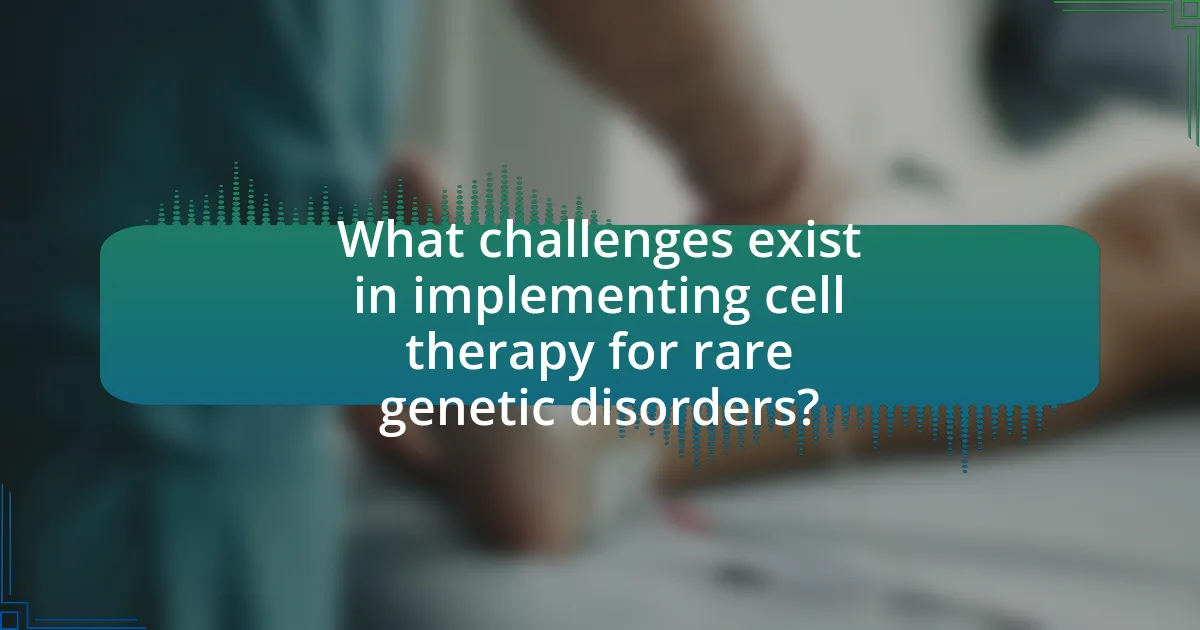
What challenges exist in implementing cell therapy for rare genetic disorders?
Implementing cell therapy for rare genetic disorders faces several challenges, including high costs, regulatory hurdles, and limited patient populations. High costs arise from the complex manufacturing processes and the need for personalized treatments, making therapies financially inaccessible for many patients. Regulatory hurdles include lengthy approval processes by agencies like the FDA, which can delay access to potentially life-saving treatments. Additionally, the limited patient populations for rare genetic disorders can hinder research and development, as the small number of affected individuals makes it difficult to conduct large-scale clinical trials, impacting the viability and marketability of these therapies.
What regulatory hurdles must be overcome?
Regulatory hurdles that must be overcome in the context of innovative approaches to treating rare genetic disorders with cell therapy include obtaining approval from regulatory bodies such as the U.S. Food and Drug Administration (FDA) and the European Medicines Agency (EMA). These agencies require extensive preclinical and clinical data demonstrating the safety and efficacy of the cell therapies. For instance, the FDA mandates that developers conduct rigorous clinical trials, which can take several years and require significant financial investment. Additionally, compliance with Good Manufacturing Practices (GMP) is essential to ensure that the cell therapies are produced consistently and safely. The complexity of the regulatory landscape is further compounded by the need for post-marketing surveillance to monitor long-term effects and efficacy after approval.
How do these regulations impact research and development?
Regulations significantly impact research and development in the field of innovative approaches to treating rare genetic disorders with cell therapy by establishing safety and efficacy standards that must be met before clinical trials can commence. These regulations ensure that therapies are rigorously tested, which can prolong the development timeline and increase costs, as companies must navigate complex approval processes set by agencies like the FDA. For instance, the FDA’s guidance on cell therapy requires extensive preclinical data and clinical trial phases, which can delay the introduction of potentially life-saving treatments to the market. Consequently, while these regulations are essential for patient safety, they can also create barriers that slow down innovation and limit the availability of new therapies for rare genetic disorders.
What ethical considerations are involved in cell therapy?
Ethical considerations in cell therapy include informed consent, the potential for exploitation of vulnerable populations, and the long-term effects on patients. Informed consent is crucial as patients must fully understand the risks and benefits before undergoing treatment. The potential for exploitation arises when therapies are offered to marginalized groups without adequate safeguards, raising concerns about equitable access. Additionally, the long-term effects of cell therapy are often unknown, which necessitates ongoing monitoring and ethical oversight to ensure patient safety and well-being. These considerations are supported by guidelines from organizations such as the World Health Organization and the International Society for Stem Cell Research, which emphasize the importance of ethical standards in clinical applications of cell therapy.
What are the financial implications of cell therapy for patients and healthcare systems?
Cell therapy has significant financial implications for both patients and healthcare systems, primarily due to its high costs and potential long-term savings. The average cost of cell therapy can range from hundreds of thousands to over a million dollars per patient, which places a substantial financial burden on individuals and insurance providers. However, successful treatments can lead to reduced long-term healthcare costs by decreasing the need for ongoing medical care, hospitalizations, and supportive therapies associated with chronic conditions. For instance, a study published in the Journal of Managed Care & Specialty Pharmacy found that gene therapies for certain genetic disorders could save healthcare systems up to $1.5 million per patient over their lifetime by preventing complications and improving quality of life. Thus, while the upfront costs of cell therapy are high, the potential for significant long-term savings makes it a financially impactful option for both patients and healthcare systems.
How do treatment costs compare to traditional therapies?
Treatment costs for cell therapy are generally higher than those for traditional therapies. For instance, the average cost of cell therapy can range from $373,000 to over $1 million per patient, while traditional therapies typically range from $10,000 to $100,000. This significant difference is largely due to the complex manufacturing processes, personalized nature of the treatments, and the advanced technology involved in cell therapies. Additionally, a study published in the Journal of Managed Care & Specialty Pharmacy highlighted that while initial costs are higher, cell therapies may lead to long-term savings by reducing the need for ongoing treatments and hospitalizations associated with traditional therapies.
What funding opportunities exist for research and patient access?
Funding opportunities for research and patient access in the context of innovative approaches to treating rare genetic disorders with cell therapy include government grants, private foundations, and industry partnerships. For instance, the National Institutes of Health (NIH) provides substantial funding through programs like the Small Business Innovation Research (SBIR) and Small Business Technology Transfer (STTR) programs, which support research and development of new therapies. Additionally, organizations such as the Cure Rare Disease Foundation offer grants specifically aimed at advancing treatments for rare diseases. Furthermore, pharmaceutical companies often collaborate with academic institutions to fund research initiatives, enhancing both access to patient care and the development of novel therapies. These funding sources are critical for advancing research and improving patient access to innovative treatments.
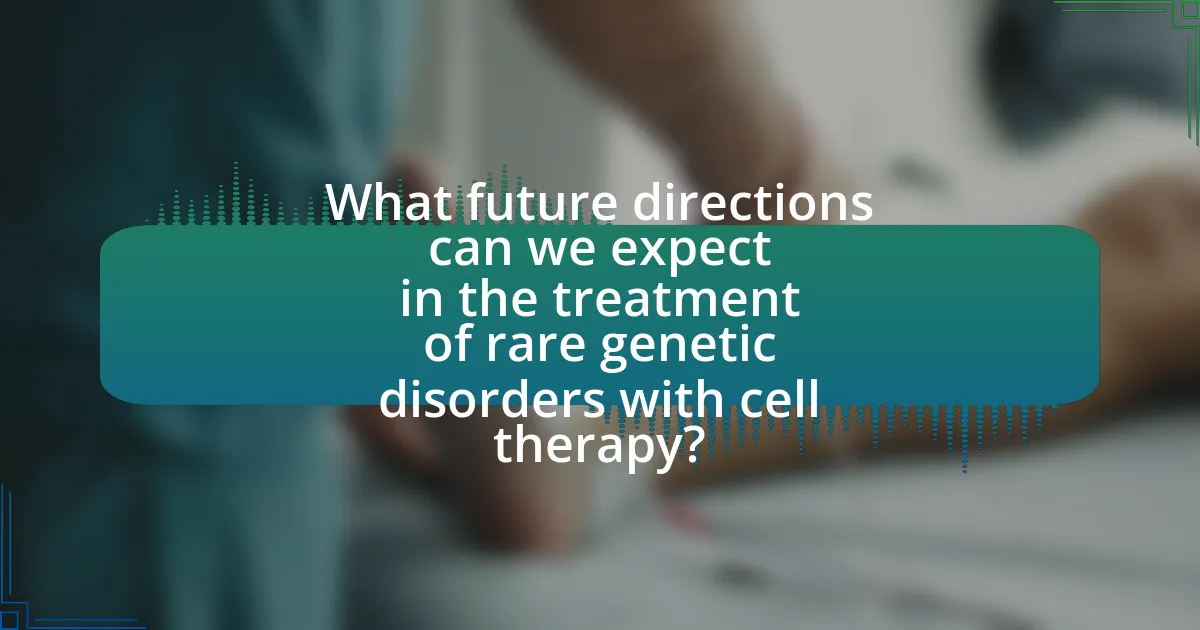
What future directions can we expect in the treatment of rare genetic disorders with cell therapy?
Future directions in the treatment of rare genetic disorders with cell therapy include advancements in gene editing technologies, such as CRISPR-Cas9, which allow for precise modifications of genetic material to correct mutations. These technologies are being integrated into cell therapy approaches, enabling the development of personalized treatments that target specific genetic defects. For instance, clinical trials are underway that utilize engineered T cells to treat conditions like sickle cell disease and beta-thalassemia, demonstrating promising results in restoring normal function. Additionally, the use of induced pluripotent stem cells (iPSCs) is expanding, as they can be derived from patients and differentiated into various cell types for transplantation, offering a potential cure for disorders like spinal muscular atrophy. The combination of these innovative techniques is expected to enhance the efficacy and accessibility of treatments for rare genetic disorders, ultimately improving patient outcomes.
How might technological advancements influence treatment options?
Technological advancements significantly influence treatment options by enabling the development of more precise and effective therapies for rare genetic disorders through cell therapy. Innovations such as CRISPR gene editing allow for targeted modifications at the genetic level, which can correct mutations responsible for these disorders. For instance, a study published in “Nature” by Doudna and Charpentier in 2014 demonstrated how CRISPR can be used to edit genes in human cells, paving the way for potential treatments for conditions like sickle cell disease. Additionally, advancements in stem cell technology facilitate the generation of patient-specific cells, enhancing the efficacy of personalized medicine. These developments collectively expand the range of available treatment options, improving patient outcomes and offering hope for previously untreatable conditions.
What role will artificial intelligence play in developing new therapies?
Artificial intelligence will play a crucial role in developing new therapies by enhancing drug discovery, optimizing clinical trials, and personalizing treatment plans. AI algorithms can analyze vast datasets to identify potential drug candidates and predict their efficacy, significantly reducing the time and cost associated with traditional methods. For instance, a study published in Nature Biotechnology demonstrated that AI could predict the success of drug candidates with up to 90% accuracy, showcasing its potential to streamline the development process. Additionally, AI can facilitate the design of clinical trials by identifying suitable patient populations and optimizing trial protocols, thereby increasing the likelihood of successful outcomes.
How can personalized medicine enhance treatment effectiveness?
Personalized medicine enhances treatment effectiveness by tailoring therapies to individual genetic profiles, which allows for more precise targeting of diseases. This approach improves outcomes by ensuring that patients receive treatments that are specifically suited to their unique biological characteristics, thereby increasing the likelihood of a positive response. For instance, studies have shown that patients with specific genetic mutations respond better to targeted therapies, such as those used in certain cancers, leading to higher survival rates and reduced side effects. By utilizing genetic testing and biomarkers, personalized medicine can identify the most effective treatment options, ultimately optimizing patient care and resource allocation in the management of rare genetic disorders.
What practical steps can patients take to explore cell therapy options?
Patients can explore cell therapy options by consulting with healthcare professionals who specialize in regenerative medicine. This initial step allows patients to receive personalized information regarding their specific condition and potential cell therapy treatments available. Following this, patients should research accredited clinical trials that focus on cell therapies for their rare genetic disorder, as these trials often provide access to cutting-edge treatments. Additionally, patients can connect with patient advocacy groups that focus on their specific disorder, as these organizations often have resources and information about available therapies and ongoing research. Engaging in discussions with other patients who have undergone similar treatments can also provide valuable insights and support.
How can patients find clinical trials relevant to their condition?
Patients can find clinical trials relevant to their condition by utilizing online databases such as ClinicalTrials.gov, which lists trials by condition, location, and phase. This platform is maintained by the U.S. National Library of Medicine and provides comprehensive information on ongoing and completed clinical trials, including eligibility criteria and contact information for trial sponsors. Additionally, patients can consult with their healthcare providers, who may have access to information about trials specific to their condition and can offer guidance on participation.
What resources are available for understanding treatment options?
Resources available for understanding treatment options for rare genetic disorders with cell therapy include peer-reviewed journals, clinical trial registries, and specialized medical websites. Peer-reviewed journals such as “Nature Reviews Genetics” and “The Journal of Gene Medicine” provide in-depth research articles and reviews on the latest advancements in cell therapy. Clinical trial registries like ClinicalTrials.gov offer information on ongoing and completed studies, detailing the treatment options being tested. Additionally, organizations such as the National Organization for Rare Disorders (NORD) and the Genetic and Rare Diseases Information Center (GARD) provide comprehensive resources and support for patients and families seeking information on treatment options. These resources are validated by their contributions to the scientific community and their role in disseminating accurate, evidence-based information.

